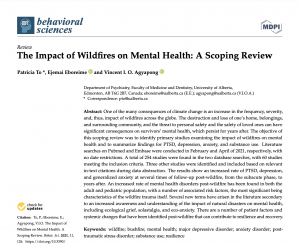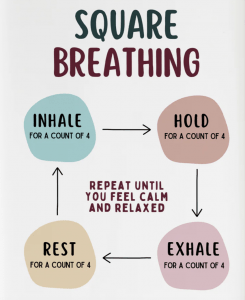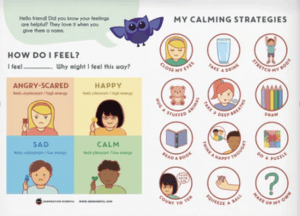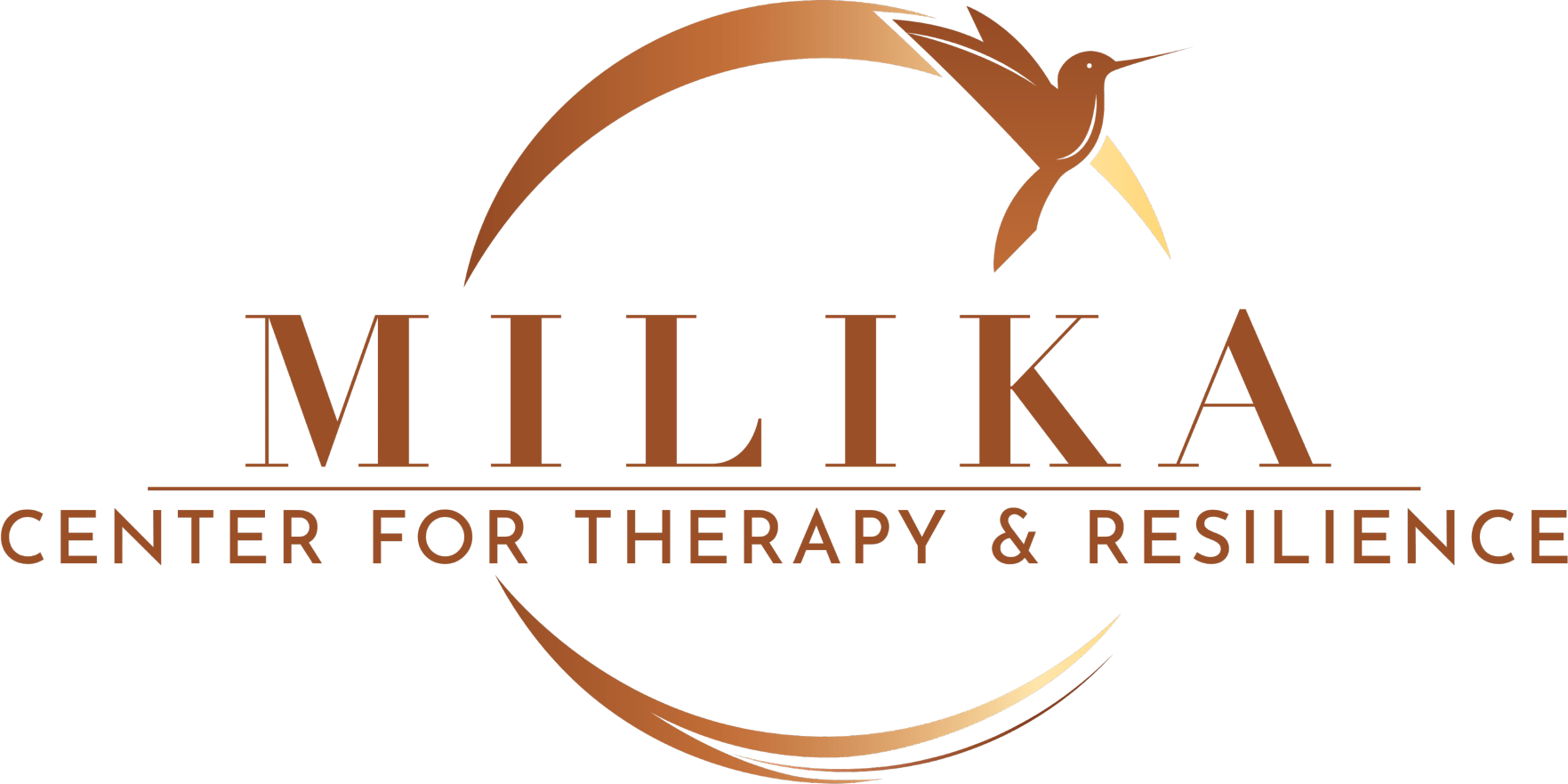MILIKA CENTER FOR THERAPY & RESILIENCE
Road to Resilience: Overcoming Trauma & Finding Strength After LA Wildfires
Highlights from the webinar by Kanchi Wijesekera, Ph.D. [January 25, 2025]
Impact of Wildfire Disasters and Mental Health

Research has consistently shown that wildfires and natural disasters can have a profound impact on mental health, affecting both youth and adults.
For youth, exposure to natural disasters can lead to increased symptoms of anxiety, depression, and post-traumatic stress disorder (PTSD), with long-term effects on emotional regulation and academic performance.
 Adults may also experience increased stress, anxiety, and depression, as well as complicated grief and PTSD.
Adults may also experience increased stress, anxiety, and depression, as well as complicated grief and PTSD.
Furthermore, the displacement, loss of property, and disruption of social support networks that often accompany wildfires can exacerbate these effects, making it essential to provide accessible and trauma-informed support services to affected communities.
DEFINITIONS
Trauma: A trauma is a psychological and emotional response to a deeply distressing or disturbing event. Trauma can affect an individual’s sense of safety, security, and well-being.
Potentially traumatic events (PTE) An event that involves actual or threatened death, serious injury, or sexual violence.
While a PTE is an event that has the potential to cause trauma, not everyone exposed to a PTE will have trauma.
TRAUMA REACTIONS ACROSS AGES
Keep in mind that these are general guidelines and that individual reactions to trauma can vary widely.
Infants
- Changes in eating patterns
- Increased or decreased activity
- Impaired sleep
- Increased crying or irritability
Note: Even if unable to speak yet, babies can be significantly impacted by the wildfires. Although they may not fully understand the event, they are highly attuned to their caregivers emotions, meaning they can sense the stress, anxiety, and changes in their environment. Common signs or symptoms at this stage include:
Preschool
- Reenactment of the traumatic event through play
- Perseveration on a specific part of the traumatic event
- More clingy than before the trauma
- Avoidance of new or specific people or situations because of trauma-related fears
- Easily alarmed, jumpy
- More fearful of being away from parent
- Strongly impacted by parental reactions
- New feeding or toileting problems, regressive behavior
School Age
- Drawing the traumatic event
- Talking about the traumatic event
- Fluctuation between being shy/withdrawn and irritable/aggressive
- Sleep problems (restless sleep, talking in sleep, waking up tired, nightmares)
- Problems with attention/concentration in school
- Physical symptoms such as stomach aches or headaches
- Reactive to reminders of the event, like a particular color, smell, or sound
Adolescents
- Fears that their flashbacks mean that they are crazy
- Avoidance of thoughts or feelings of the traumatic event
- Use of drugs or alcohol to decrease arousal or avoid memories of the traumatic event
- Increased irritability
- Problems with attention/concentration in school when they have no previous history of attention problems
- Sleep problems (including avoidance activities like night studying, television watching, etc.)
SCHOOL SETTING:
Trauma impacts a student’s ability to learn, behave, and interact with peers and teachers.
In the classroom setting, this may manifest as:
- Hypervigilance: easily startled, “on the look out” for threats, difficulty paying attention
- Emotional dysregulation: explosive behaviors, mood swings, irritability
- Avoidance: school refusal, reluctance or refusal to participate in activities
- Aggression: verbal or physical altercations with peers or teachers
- Dissociation: appears “checked out”, disconnected from classroom setting
- Withdrawal: appear shut down, withdrawn, quiet, passive
- We may see this impact academic performance, like a decline in grades.
Distress does not mean psychopathology. Feeling overwhelmed or distressed does not necessarily mean you have a mental health disorder
It’s normal it feel anxious in anxiety-producing situations. Wildfires are traumatic events, it’s normal to feel scared.
Trauma Reminders
Trauma reminders are certain people, places, things, or situations can trigger strong emotional and physiological reactions.
These trauma reminders transport an individual back to the experienced trauma, making them feel as if they are reliving it. Sometimes this can be overwhelming, but with recognition and practice of strategies, we can cope and find healing.
Examples related to the wildfires:
- Smoke, fire alarms, emergency vehicles
- Strong winds
- Darkness, power outages
- Helicopter sounds
- News reports or social media updates about the wildfires
- Certain sounds or smells associated with the fires
- Anniversary dates related to the wildfire
- Loss reminders- birthdays, empty chair at the dinner table, school lunch time, etc.
The Amygdala – The “Car Alarm” Metaphor
- The amygdala is a small, almond-shaped structure located in the temporal lobe of the brain.
 Think of it as our threat detection center. When the amygdala perceives a threat, it triggers the body’s “fight or flight” response, releasing stress hormones like adrenaline and cortisol.
Think of it as our threat detection center. When the amygdala perceives a threat, it triggers the body’s “fight or flight” response, releasing stress hormones like adrenaline and cortisol.- Metaphor: the “car alarm.” When a car alarm detects a potential threat (like someone breaking into the car), it sounds a loud, piercing noise to alert the owner and deter the intruder. However, the same alarm will turn off if the tennis ball hits the car while kids are play catch (a false alarm).
- In the context of trauma and wildfires, the amygdala’s car alarm metaphor can help individuals understand why they may be experiencing heightened anxiety or fear responses, even if the immediate danger has passed.
Resilience
“Resilience is the process and outcome of successfully adapting to difficult or challenging life experiences, especially through mental, emotional, and behavioral flexibility and adjustment to external and internal demands.”
– American Psychological Association
- Resilience serves as a protective factor, buffering against the negative effects of disaster on mental health.
- By developing various coping strategies, individuals can improve their resilience and better navigate challenging situations.
- With time and practice, the amygdala’s “car alarm” can become less sensitive, and individuals can regain a sense of control and confidence.
- The majority of people and children are resilient, meaning they have the capacity to bounce back from adversity
Eight Grounding Strategies to Regulate the Nervous System
Grounding strategies are techniques that help you focus on the present moment, helping to reduce feelings of anxiety, panic, or dissociation.

- Breathing exercises (ex. Belly breathing, 5-finger breathing, box breathing)
- Progressive muscle relaxation – tighten and soften various muscle groups.
- Mindfulness meditation (ex. Body scans, meditation, sound meditations)
- 5-4-3-2-1 method: identify five things youcan see, four things you can feel, three things you can hear, two things you
 can smell, one thing you can taste
can smell, one thing you can taste - Safety mantras – repeating reassuring statements repeatedly can be a powerful tool that helps calm the nervous system. These mantras can be repeated silently or out loud, whenever feelings of anxiety or fear arise.
-
- “I am safe” “I am safe enough right now”
- “I was in danger then and there, I am in the here and now”
- “I can be at ease because my loved ones and I are safe”
6. Soothing touch – placing one hand on your heart and the other on your stomach. Research has shown this can be just as effective at reducing stress hormones as an actual hug from someone else!
Couples research (Gottman) has also shown that a 6-second kiss can help lower stress hormones and increase oxytocin (the ‘love hormone’).
7. Laughter – watching funny videos, making jokes can help!
8. Gratitude practice – gratitude can help shift the mindset from SCARCITY → ABUNDANCE
- Gratitude can activate the brain’s reward center, releases serotonin, dopamine
- Decreases cortisol
- E.g. journal, share gratitude with others, gratitude rituals with the family, gratitude jar
Trauma-Informed Parenting Strategies
Tip 1: Create a safe and predictable environment
- Establish a daily routine
- Create a “calming corner”
- Classroom – “Quiet Areas” for students can help
- Minimize curveballs. Give advance notice for changes, when possible
- Leave kids with familiar people when parents have to be away. Similarly for school, request for the same substitute teacher when possible.
- Use visual reminders, such as schedules or charts, to help children feel more secure and offer predictability.
- Be intentional about prepping your class for incom
 ing students – encourage empathy, kindness, understanding.
ing students – encourage empathy, kindness, understanding.
A Calming Corner
- Create a calming corner together with your child
- Keep some their favorite comforting items for easy access
- Use the poster to help identify feelings and coping skills to practice together
- Resource: Generation Mindful: www.genmindful.com
Tip 2: Communicate with your child in an age-appropriate manner.
- Emphasize safety: Reassure them that they, you, their friends, and teachers are safe.
-
Speak truthfully: Share information that is accurate and easy to understand. Knowing what is happening helps them make sense out of their experiences.
-
Consider their developmental stage: Avoid overwhelming them with too much information.
-
Start with a simple explanation: “Here’s what we know so far. There was a fire in the mountains, and we had to leave our home to stay safe.”
-
Provide context: “The firefighters worked super hard to put out the fire, but it was really hard because of the strong winds.”
-
Acknowledge the impact: “Unfortunately, the fire burned some houses, trees, and buildings.”
Our home/school…
-
If your home was affected: “I want to talk to you about something that’s really hard for me to say. Our home was burned in the fire, and everything we had inside is gone. I’m heartbroken because our home held so many special memories. At the same time, I’m thankful that we’re all safe. We’ll be staying with grandma until we can make a new plan“
-
If your child’s school was affected: “The school was also burned, but your friends and teachers are safe. We’ll find a way to stay in touch with them, and we’re working on a plan for school.“
Tip 3: Monitor media and social media exposure
- Get the necessary updates and then be intentional about minimizing exposure to media.
- Images of the fire and its destruction can be frightening
- Recurrent exposure can heighten the risk of trauma
- Risk of vicarious trauma when hearing really distressing narratives of others
- Share about the risks with your children who have access to social media and encourage them to take breaks from it.
Tip 4: Encourage Emotional Expression
-
Provide opportunities for children to express their feelings through various mediums, such as:
-
Art (drawing, painting, coloring)
-
Stories (writing, storytelling, puppet shows)
-
Conversations (one-on-one, group discussions)
-
Play (using stuffed animals or dolls to act out scenarios)
-
-
Use open-ended questions to encourage communication, such as: “I know things have been rough – how are you doing today?” “What’s been on your mind lately?” “What are you worried about the most?”
-
Encourage children to think critically and develop problem-solving skills by asking: “What do you think might be helpful for you in this situation?” “How can we work together to make staying at grandma’s house a bit better?”
-
Foster a sense of control and agency by involving children in decision-making processes and offering choices.
-
Practice active listening by:
-
Maintaining eye contact
-
Nodding to show understanding
-
Reflecting back what you’ve heard
-
Validate children’s emotions by acknowledging and accepting their feelings, saying:
-
“I know this has been a really tough time. It’s okay to feel scared/sad/angry/unsure.”
-
“I’m here for you, and I’ll support you through this.”
-
-
-
Avoid dismissing or minimizing their emotions, as this can exacerbate feelings of helplessness and uncertainty.
-
Establish clear boundaries while still being empathetic, saying:
-
-
“I understand you’re feeling angry, but it’s not okay to hit me. Let’s find a different way to express your feelings.”
-
-
-
“I know you’re scared, but it’s not safe to go outside right now. Let’s find a way to stay safe together.”
-
Tip 5: Allow for storytelling from a resilient lens
-
Allow your child to share their story in a way that feels comfortable for them, whether through:
-
Verbal narration
-
Acting or role-playing
-
Drawing or art
-
Play
-
-
Listen attentively to their story, and:
-
Gently clarify any misperceptions (e.g. dad left home while we were packing up because he needed to pick up your brother from the neighbors house. It was important for him to come home so we can leave together and be safe).
-
Help identify and validate their feelings
-
Take breaks if needed
-
Highlighting Resilience and Positivity
-
Emphasize the resilience and strengths demonstrated by your child and family during the challenging situation (e.g. “you did such a good job listening to my directions when we were evacuating;” “We really problem-solved so well together and it helped us come to grandma’s house without any issues“).
-
Shed light on the “silver linings” – the positive aspects or lessons learned from the experience
-
Identify the “heroes” – the individuals who provided support and help during the crisis
-
Highlight the effectiveness of your family’s support system and the strategies that contributed to everyone’s safety
NOTE: Be mindful of your own emotional triggers and reactions as you support your child’s storytelling. Take care to manage your own emotions, ensuring that you remain a calm and supportive presence for your child
Tip 6: Model Healthy Coping Behaviors and Emotional Regulation
- Model healthy coping behaviors
- Have your own toolbox: Take a break, deep breaths, exercise/yoga, read, journal, or mindful meditations
- Narrate your own feelings and your choice of coping tools (e.g. I’m feeling really stressed and in the orange zone right now. I’m going to take a quick shower because that really helps me feel better. I’ll be back in about 15 mins. ”
- Teach children healthy coping strategies and emotional techniques.
- Name it to tame it
- “I can see that you’re sad and feel like crying right now. I’m wondering if you would like a hug and have some quite time together on the couch, or go outside and throw the ball around ” […or “is there something you would like to do to feel better…“]
Tip 7: Strengthen child’s friendships and peer support
- Staying connected to friends can reduce the impact of physical separation.
- Mom will always be here for you, is even better if you can add on “Mom will always be here for you AND so will your teachers, neighbors, coach, auntie. You have a lot of people that care for you.”
- Helps them see their wide support network, a safety net that can catch them.
- Consider:
- Virtual play dates
- Facetime Calls
- In-person play dates when possible
Tip 8: Provide opportunities for control and choice
- Offer choices and involve children in decision-making processes, such as choosing meals or activities.
- Do you prefer spaghetti or baked chicken for dinner?
- Would you like to wear this green shirt or the new yellow one today?
- If they are stuck with a situation, help with problem-solving: “SNAP problem solving”
- S – State the problem
- N – Name the goal
- A – All possible solutions (review pros & cons)
- P – Pick the best one
Tip 9: Parent self-care
A parent’s trauma distress can impact their child’s emotional well-being, but this doesn’t mean you’re to blame. To best support your child, it’s essential to prioritize your own emotional care and well-being (e.g. put your oxygen mask on yourself first), as this will enable you to provide the comfort and stability they need.
- Regulate your nervous system – use the grounding strategies (breath work, mantra, movement, hugs, gratitude)
- Give yourself permission to feel – Tune in, give yourself permission to feel your emotions, cry and release.
- Consider routines for turning off work (e.g. listening to your favorite uplifting playlist on the drive home, a relaxing shower right after work, etc).
- Seek support from family & friends who can hold space for you.
- Practice self-compassion (Kristin Neff)
- Mindful
- Self kindness
- “Common humanity” / shared human experience
- (Lowers cortisol, de-activates the alarm system)
Tip 10: Seek support for your children, yourself, and your family
- Early intervention is KEY!
- Minimize suffering, potentially prevent onset or worsening of symptoms
- Untreated trauma symptoms can lead to a wide range of negative outcomes
- Consider resilience skill-building sessions given the adversity your family has gone through with the wildfires – could potentially prevent concerns from emerging later on.
RESOURCES
Below, you’ll find additional resources, including some mentioned during the webinar, to support you and your loved ones on your journey to resilience.
Resources for Children and Families
Scripts for Talking to Children: Dr. Becky Kennedy, Good Inside
PDF: Dr Becky _ Navigating _ WildFires (1)
After a Crisis: Helping Young Children Heal: Handout from The National Child Traumatic Stress Network (NCTSN): https://www.nctsn.org/sites/default/files/resources//after_a_crisis_helping_young_children_heal.pdf
Trinka and Sam: The Big Fire: Storybook for processing wildfire trauma with young children (NCTSN):
 English: https://www.nctsn.org/sites/default/files/resources//trinka_sam_the_big_fire.pdf
English: https://www.nctsn.org/sites/default/files/resources//trinka_sam_the_big_fire.pdf
Spanish: Trinka & Juan: El Gran Fuego: https://www.nctsn.org/sites/default/files/resources//trinka_sam_the_big_fire_sp.pdf
Childhood Traumatic Grief: Handout for parents/caregivers (NCTSN).
https://www.nctsn.org/sites/default/files/resources/fact-sheet/childhood_traumatic_grief_information_for_parents_and_caregivers.pdf
Additional Resources
My Calming Corner Strategies Poster: Generation Mindful
Time-in Toolkit: Generation Mindful
https://genmindful.com/products/the-time-in-toolkit
Free Slumberkin “Sprite” Toy: For grieving children
- Email: california@slumberkins.com
- Slumberkins instagram page for more info: https://www.instagram.com/p/DEntEqVywqA/?utm_source=ig_web_copy_link&img_index=1
Community Support
Free Hot Meals:
World Central Kitchen (WCK) distribution sites: https://wck.org/news/meal-locations-ca
World Central Kitchen Instagram Page about Distribution Sites: https://www.instagram.com/p/DEqAGCUufbz/?igsh=MXRxZHJiMXptbzh6dw%3D%3D
Temporary Childcare Support:
LA Family Support is offering up to 3 days of child care, camps, or nannies to those affected by the fires. If you’re a parent or guardian in need of child care or camps during this difficult time, please fill out the form on this website (scroll down to the “Get Care or Donate” Button): https://lafamilysupport.com
Emergency Mental Health Support:
In case of a life-threatening emergency, please call 911 or visit your nearest emergency room immediately. For additional emergency support, please reach out to the following resources:
National Suicide Line – 988 or 800-273-8255
National Youth Crisis Hotline – 800-442-4673
Crisis Text Line – text HOME to 741741, or dial 988 for 24/7 crisis support (English and Spanish available)
Childhelp National Child Abuse Hotline (call/text) – 800-422-4453
FREE CONSULTATION AT MILIKA CENTER FOR THERAPY & RESILIENCE
As a reminder, we’re offering a complimentary 20-minute phone consultation. Please don’t hesitate to reach out if you have any questions or concerns.
Milika Center for Therapy & Resilience
- Locations: Encino & Brentwood, CA
- Email: info@milikacenter.com
- Phone: 310-800-7112
- Website: www.milikacenter.com
Thank you again for your interest in this critical topic. We’re committed to supporting individuals and communities affected by trauma and wildfires.
